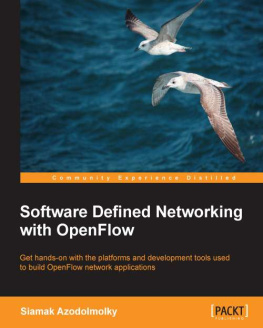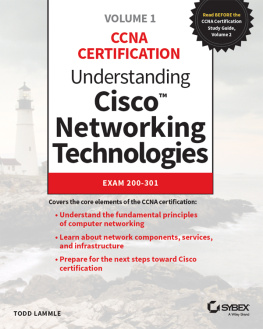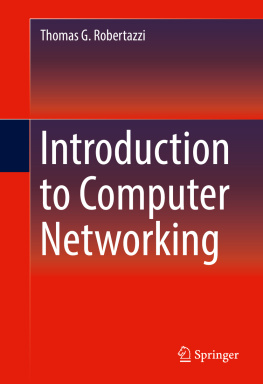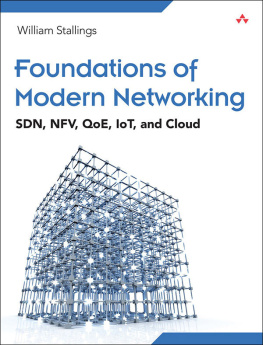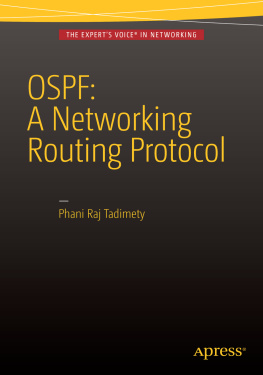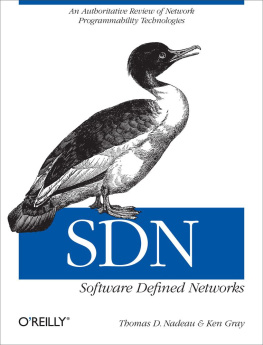Siamak Azodolmolky - Software Defined Networking with OpenFlow
Here you can read online Siamak Azodolmolky - Software Defined Networking with OpenFlow full text of the book (entire story) in english for free. Download pdf and epub, get meaning, cover and reviews about this ebook. year: 2013, publisher: Packt Publishing, genre: Computer. Description of the work, (preface) as well as reviews are available. Best literature library LitArk.com created for fans of good reading and offers a wide selection of genres:
Romance novel
Science fiction
Adventure
Detective
Science
History
Home and family
Prose
Art
Politics
Computer
Non-fiction
Religion
Business
Children
Humor
Choose a favorite category and find really read worthwhile books. Enjoy immersion in the world of imagination, feel the emotions of the characters or learn something new for yourself, make an fascinating discovery.
- Book:Software Defined Networking with OpenFlow
- Author:
- Publisher:Packt Publishing
- Genre:
- Year:2013
- Rating:4 / 5
- Favourites:Add to favourites
- Your mark:
Software Defined Networking with OpenFlow: summary, description and annotation
We offer to read an annotation, description, summary or preface (depends on what the author of the book "Software Defined Networking with OpenFlow" wrote himself). If you haven't found the necessary information about the book — write in the comments, we will try to find it.
Get hands-on with the platforms and development tools used to build OpenFlow network applications
Overview
- Get to grips with the essentials of OpenFlow and its ecosystem features
- Thorough overview of OpenSource switches, controllers, and tools
- Build your own laboratory and develop your own networking apps
In Detail
OpenFlow is an open interface for remotely controlling tables in network switches, routers, and access points. It is considered a turning point in Software Defined Networking (SDN), data center networking and virtualization as, more secure and efficient data centers are being built using OpenFlow. It defines a protocol that lets a controller use a common set of instructions to add, modify, or delete entries in a switchs forwarding table.
Starting with an introduction to SDN and OpenFlow, you will learn about the role of each building block, moving onto demonstrations of how SDN/OpenFlow can be used to provide new services and features, which will change the way that networking works and the innovative business impacts. By the end of this practical guide, you will have an insight into the Software Defined Networking and OpenFlow fundamentals.
Packed with detail, this book will walk you through the essentials; you will learn about the OpenFlow protocol, switches, and controllers. Following on from this, you will be taken through a number of practical, hands-on examples on how to use a network emulation platform called OpenFlow laboratory. You will learn how to develop your innovative network application using the OpenFlow controllers API quickly, and test your network application without commissioning any OpenFlow hardware equipment. You will also be introduced to the concept of Software Defined Networking and the details of OpenFlows protocol, along with the building blocks of an OpenFlow networking deployment. This book will teach you how to setup your OpenFlow/SDN laboratory using state-of-the-art technology and open source offerings.
What you will learn from this book
- Utilize OpenFlow for Cloud computing networking
- Discover the variety of OpenSource tools to improve your OpenFlow experience
- Learn how to build an SDN laboratory using OpenDaylight controller and Mininet
- Employ network virtualization using OpenFlow
Approach
A step-by-step, example-based guide which will help you gain hands-on experience with the platforms and debugging tools on OpenFlow
Who this book is written for
If you are a network engineer, architect, junior researcher or an application developer, this book is ideal for you. You will need to have some level of network experience, knowledge of broad networking concepts, and some familiarity with day- to- day operation of computer networks. Ideally, you should also be familiar with programing scripting/languages (especially Python and Java), and system virtualization.
Siamak Azodolmolky: author's other books
Who wrote Software Defined Networking with OpenFlow? Find out the surname, the name of the author of the book and a list of all author's works by series.

